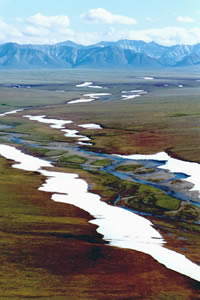
 |
Alaska's ANWR: Shorebird meccaJuly 17, 2007Courtesy of Far North Science 
1002 Area: looking toward Brooks Range Research led by Stephen Brown, of the Manomet Center for Conservation Science, has documented that an estimated 230,000 shorebirds nest in the area proposed for drilling, including 13 percent of North America's pectoral sandpipers. That makes the 1.6-million-acre "1002 area" between the Brooks Range foothills and the chilly Beaufort Sea a worldclass shorebird zone, more than qualified for international protection, according to Brown. The (230,000) total is more than twice the biological criterion for classification in the Western Hemisphere Shorebird Reserve Network (WHSRN) as a Site of International Importance (100,000 birds) and more than 10 times the threshold for qualification as a Ramsar Wetland of International Importance (20,000 birds). The percentage of North America's population of Pectoral Sandpipers breeding in the area, more than 13 percent, also exceeds the standard WHSRN uses to define sites of international importance (10 percent).
Red-necked Phalarope female in ANWR Whether to develop oil and gas reserves in the 1002 Area has been a subject of intense debate for years. Yet until this survey, conducted in 2002 and 2004, the population sizes and distributions of nesting shorebirds was unknown. The area occupies 1.6 million acres between the Beaufort Sea and the foothills of the Brooks Range at the northern edge of the 19 million-acre Arctic refuge. It is bounded by the Canning River to the west and the Aichilik River to the east. "Our data indicate that nesting shorebirds tend to associate with wetland and riparian habitats that are unevenly distributed on the coastal plain," the researchers wrote in the February 2007 issue of The Condor, the journal of the Cooper Ornithological Society. "The importance of these habitats for breeding shorebirds, many of which have declining populations, should be considered when making management decisions. Any future changes occurring in these habitats would have disproportionate effects on breeding shorebirds." |
|